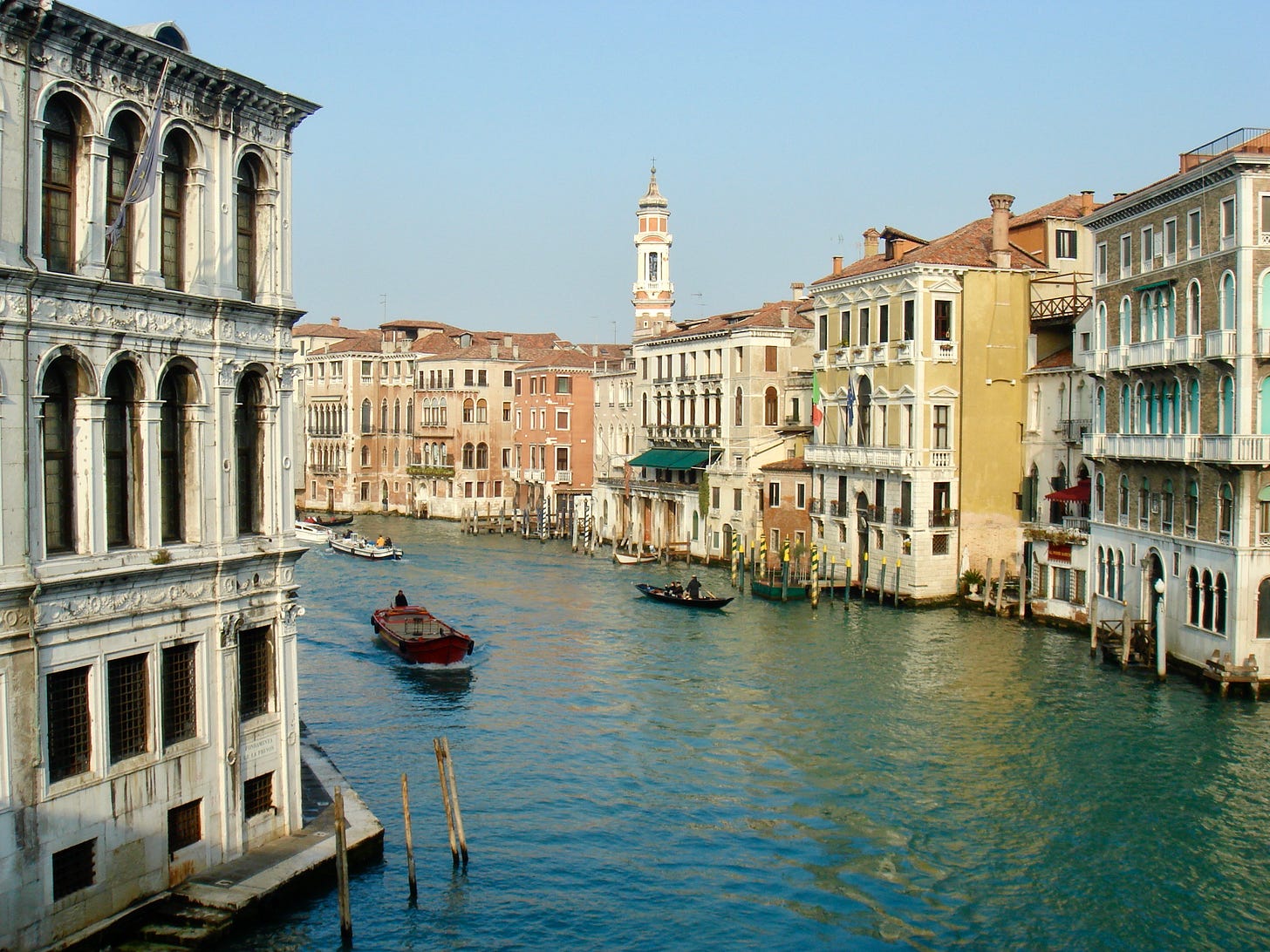How Not to Tourist
A collection of stupid, dangerous, destructive acts that will (if you have any sociocultural conscience whatsoever) plummet you into despair
Cari amici,
It’s the height of tourist season in Italy, where our collective post-Covid-lockdowns yearning to travel has obliterated shoulder season. Overtourism is here, and it’s real. And with it comes a mind-boggling array of tourist misbehavior both petty and criminal, accompanied and/or motivated by stupidity, narcissism, thoughtlessness, disrespect, ignorance, and anything else (like, say, needing to boost their followers on TikTok or Instagram) that might lead visitors to do whatever the hell they please while on Italian soil.
If you think this kind of behavior is nothing to get in a snit about, Italy would say you’re wrong (see “Consequences in the works,” below). It’s gotten so bad that someone in Venice said “Basta!” in a very public way, by creating an Instagram account called “Venezia NON è Disneyland.”
And now, prepare to be horrified. I’ve gathered these appalling acts here, some of which I’m sure you’ve heard or read about, because it’s in seeing them as a whole that the scope of human idiocy becomes depressingly obvious. And remember, this is just Italy. These things happen all over the world, committed by culprits of all ages, from children to seniors, and of diverse nationalities. (My sources are listed at the end. I cross-checked a lot of them, and some of the details vary among sources. Regardless, the incidents are real.)
Water, water, everywhere
Venice’s famous canals are a constant source of temptation, apparently, because a confounding number of visitors seem compelled to use them for water sports. Sure, the canals are evocative and romantic, and they look refreshing on a hot day—but they’re also a) UNESCO-protected, and b) a sewer system.
So how, exactly, have tourists frolicked in those murky waters? Like this: by diving off the Accademia Bridge (a Scot), skinny-dipping in the waters near the Arsenale, a complex of former shipyards and arsenals that dates to 1303 (two Americans); and going for a presumably clothed swim (47 people in 2022). One of them, an Englishman, swam across the Grand Canal (he tweeted about it) to emulate poet Lord Byron, who had swum the canal in the 1800s (when it was no doubt considerably cleaner) in a competition with friends. Another, a 30-year-old Czech woman, swam in the lagoon before posing, topless, for photos at the Partisan Woman war memorial near the Biennale.
Not everyone wants to get in the water. But they do want to get on it. Two Australians cruised the Grand Canal on electric surfboards, and tourists have stolen water taxis, a vaporetto (equivalent of a bus), and gondolas. In one case, gondola thieves fell off their stolen transport into January-frigid canal waters. “By the time we reached them,” said Chief Commissioner Gianfranco Zarantonello of the Venice police department, “one of them was dying of hypothermia. We saved him.”
Rome, like Venice, has lots of tempting water. It’s common knowledge that the occasional tourist can’t resist imitating Anita Ekberg in La Dolce Vita by taking a dip in the Trevi Fountain, but the Trevi isn’t alone in being used as a personal swimming pool. In the Testaccio neighborhood, a young woman (reportedly an American) sunbathed naked before bathing in the Fontana delle Anfore, and three German tourists headed over to Piazza Barberini to frolic in Bernini’s 17th-century Tritone fountain in their underwear.
Cooling off can be pricey, though, if you’re caught. The three Germans were fined more than €1,500.
“But I have needs!”
In Florence, cluelessness and menefreghismo rule the day. In the world-famous Uffizi Galleries, a woman sat surrounded by treasured and important art—and instead of gawking, she gave herself a pedicure. Not far away, at the top of Florence’s Duomo, a Canadian tourist saw no reason not to urinate on the beloved, iconic cathedral’s summit; after all, there was no bathroom. He was fined €400, and he got off easy—I’d have handed him a scrub brush and a bar of soap and escorted him right back up those 463 steps to clean up his mess.
The apparently universal desire to say “I was here”
In Venice, in nine months of 2022, 46 tourists wrote on, carved into, or otherwise defaced the city’s monuments, including bridges and the Basilica del Santissimo Redentore (permanently damaged by an Italian tourist). And in Florence, a Turkish tourist wrote her name on the Ponte Vecchio in nail polish, while a young German girl chose to use a felt-tip pen.
But Rome takes first place in the defacement race. Apparently the Colosseum is the most irresistible place for those desperate to leave proof of their existence. A recent example is the dude named Ivan who carved “Ivan+Haley 23” on a Colosseum wall. I hope he really got his jollies because if he’s convicted he’ll face a fine of at least €15,000 or up to five years in prison. Other cretins who’ve committed similar acts of vandalism include a 30-year-old Canadian who carved her initials with a stone, and a 39-year-old Israeli tourist who carved not only her own initials but those of her whole family onto a Colosseum wall. The Israeli woman has been charged with aggravated damage of a building of historical and cultural interest.
Not far from the Colosseum stands the 2,000-year-old Arch of Augustus, another temptation. In 2015 and 2022, two American couples carved their initials into the monument. One couple, who enclosed their initials in a heart, was fined €800.
For some tourists, leaving their mark isn’t enough; they must also steal. Pieces of the Colosseum have gone home with tourists—or almost. Recently, a Canadian teen hid a brick in her backpack, but it wasn’t her lucky day. Irate onlookers reported her, and the brick was returned.
Sex, alfresco or among the ruins
Florence is hella romantic, but having sex in a heavily trafficked public is a bit sketch. Isn’t it? Not for some visitors. In 2012, a couple copulated under the statue of Dante in Piazza Santa Croce, provoking the mayor to say that the area had turned into an “open-air brothel.” And an Australian couple thought a bench by the Ponte Vecchio, an area packed with people, was a perfectly fine place for their lovemaking.
In the red light district of ancient Pompeii, brothels were frescoed with explicit sex scenes—the perfect place for a threesome, thought a Frenchman and two Italian women who climbed a fence to break into the area. Unfortunately for them, they were caught in the act (whatever it was) and fined. One source reports them saying they’ll be back to try again.
Smashing, bashing, and crashing
Last year two American tourists in Rome, both reportedly drunk, made headlines when they caused €25,000 worth of damage by throwing their scooters down the Spanish Steps (which had been restored, to the tune of €1.5 million, in 2016). Each was fined an outrageously paltry €400, and both were banned from the area for six months. Subsequently, one of them was charged with damaging a monument, punishable with up to a year in jail or a fine of at least €2,000.
Perhaps the American couple was inspired by the actions of a Saudi tourist who drove a Maserati down the travertine staircase, breaking at least two of the steps. (Travertine, a form of limestone, is hard, but not as resilient as marble or granite.) The driver claimed he made a wrong turn. Yeah, right.
Vatican Museums workers take note! Do not, I repeat, do not tell tourists they can’t see the Pope. A 65-year-old American, after being given such distressing information, destroyed two ancient Roman sculptures in the Museo Chiaramonti, smashing one deliberately and knocking the other one down when he tried to escape.
Then there’s the American tourist in Florence’s Museo dell'Opera del Duomo who, in 2013, “accidentally” broke a finger off a 600-year-old statue (thought to be of the Virgin Mary and thought to be by sculptor Giovanni d'Ambrogio). Supposedly he was measuring it. Sounds fishy to me, and it did to the authorities too, who questioned whether the damage was accidental. Small consolation: the finger wasn’t original to the work.
“What, me read?” or, “That sign doesn’t apply to me”
In Rome, four teenage English tourists (drunk, natch) climbed into the Colosseum Archaeological Park early one morning, and were spotted and nabbed in the Roman Forum. The price of admission, for them? A trespassing charge and €1,600.
And back in Pompeii, within the archeological park, an Australian riding a moped took a spin around the ancient city walls, traveling about a mile on a dirt service road before being stopped. Though he entered the service gate surrounded by service vehicles, he claimed he didn’t know the road wasn’t open to the public.
Nearby, on the slopes of Mt. Vesuvius, an American family skirted the visitor entrance to the volcanic park and took an off-limits path (clearly marked as such) to the summit, where one of them, a 23-year-old man taking a selfie, fell several yards into the 1,000-foot crater and got stuck. He was hauled out on a rope and taken into custody.
It was the drone’s fault
Now that drones allow anyone to do aerial photography, where better to grab spectacular overhead shots than Italy? Thing is, there are EU, Italian, regional, and even city regulations to comply with, so drone owners need to do their homework first. They also need to have some common sense, sadly lacking in some Mexican tourists who flew their drone in Pisa and hit the Leaning Tower. Ditto for the Argentinean tourist in Rome who crashed his drone on the roof of Palazzo Venezia.
“Geez, what’s the big deal?”
Some tourists in Venice who displayed a stunning lack of propriety caused no damage—but they could have. Among them were a Belgian tourist who rode a Vespa in the pedestrianized waterfront zone, two Germans who brewed coffee on a portable stove near the Rialto Bridge steps, and a party of four (two Germans, two Czechs) who dined on top of a medieval well.
Consequences in the works
As of April 2023, a bill is in the works that, if it becomes law, would levy serious penalties for the kind of defacements and damages listed here. Fines would range from €10,000 to €60,000. I’m all for it.
Thoughts? Experiences? Years ago I was dismayed to see graffiti (scrawled names, nothing artistic) lining the walls of the stairs to the top of St. Peter’s in Rome. I’ve since seen plenty of vandalism but never the vandals in action—and if I ever do, I hope I’ll have the guts to challenge them. I have zero tolerance. Zero.
Alla prossima,
Cheryl
© 2023 Cheryl A. Ossola
Sources (partial list)
https://edition.cnn.com/travel/article/italy-tourists-bad-behavior/index.html
https://www.wantedinrome.com/news/tourists-behaving-badly-in-italy.html
https://www.saturdaysinrome.com/blog/traveling-to-italy-dont-be-these-people
https://www.ditisitalie.nl/top-10-zich-misdragende-toeristen-in-italie/
https://www.lonelyplanet.com/news/what-not-to-do-as-a-tourist-in-italy
https://www.nytimes.com/2022/06/09/world/europe/spanish-steps-damaged-scooter.html
https://edition.cnn.com/travel/article/vatican-museum-tourist-smashes-statues/index.html
P.S. My book! Which you can buy here or on the usual sites. Another fab option is to ask your local library to stock it.
If you read it and like it, please tell your friends and/or leave a few lines of praise on any bookish site. You’ll make me over-the-moon happy. Baci!







*screaming internally*
These acts are so disturbing. I appreciate you shedding light on this issue. I just dont understand why one would venture to Italy (or anywhere) and destroy it.
My dream is to go to Italy. Soon I hope!